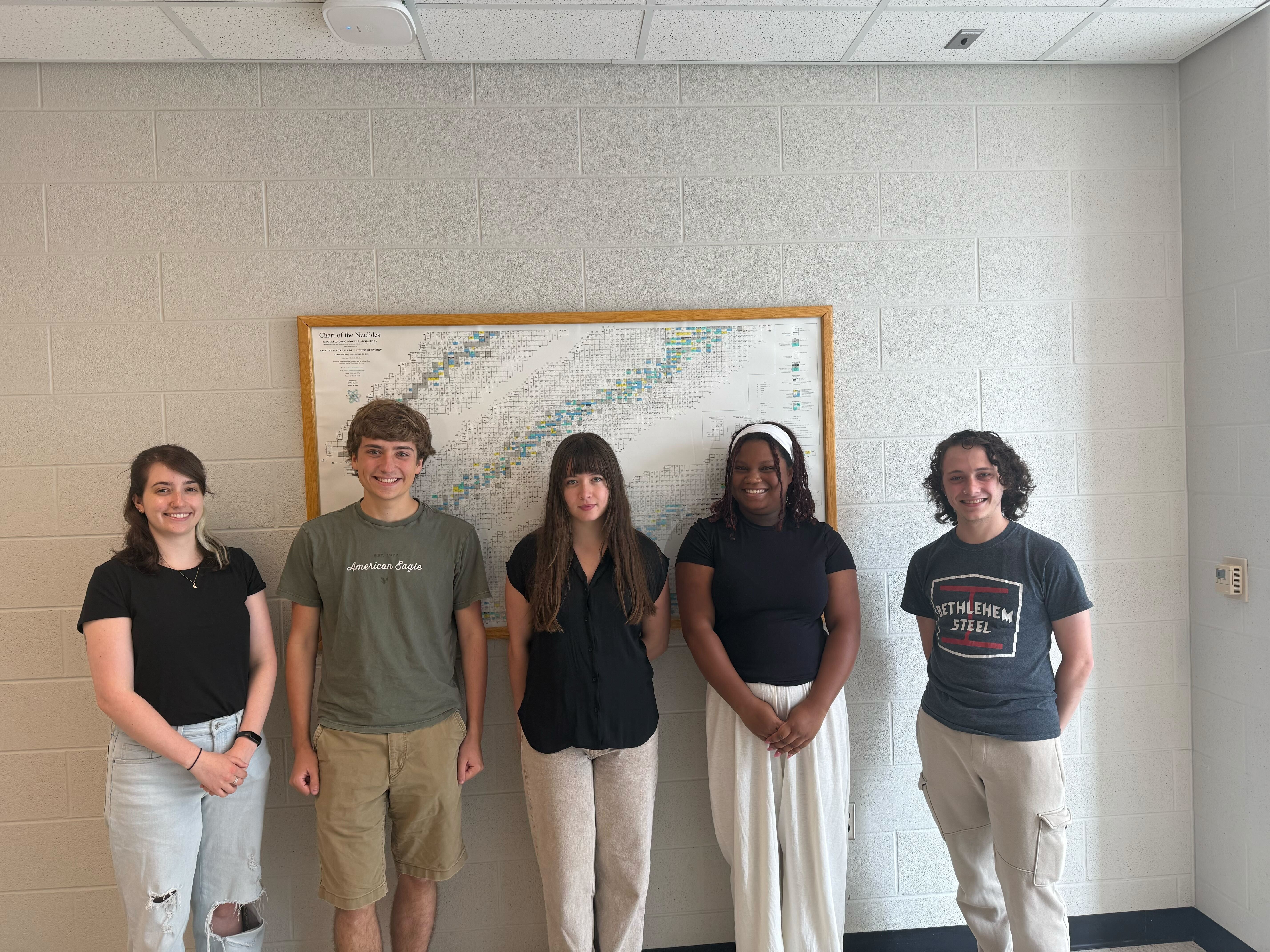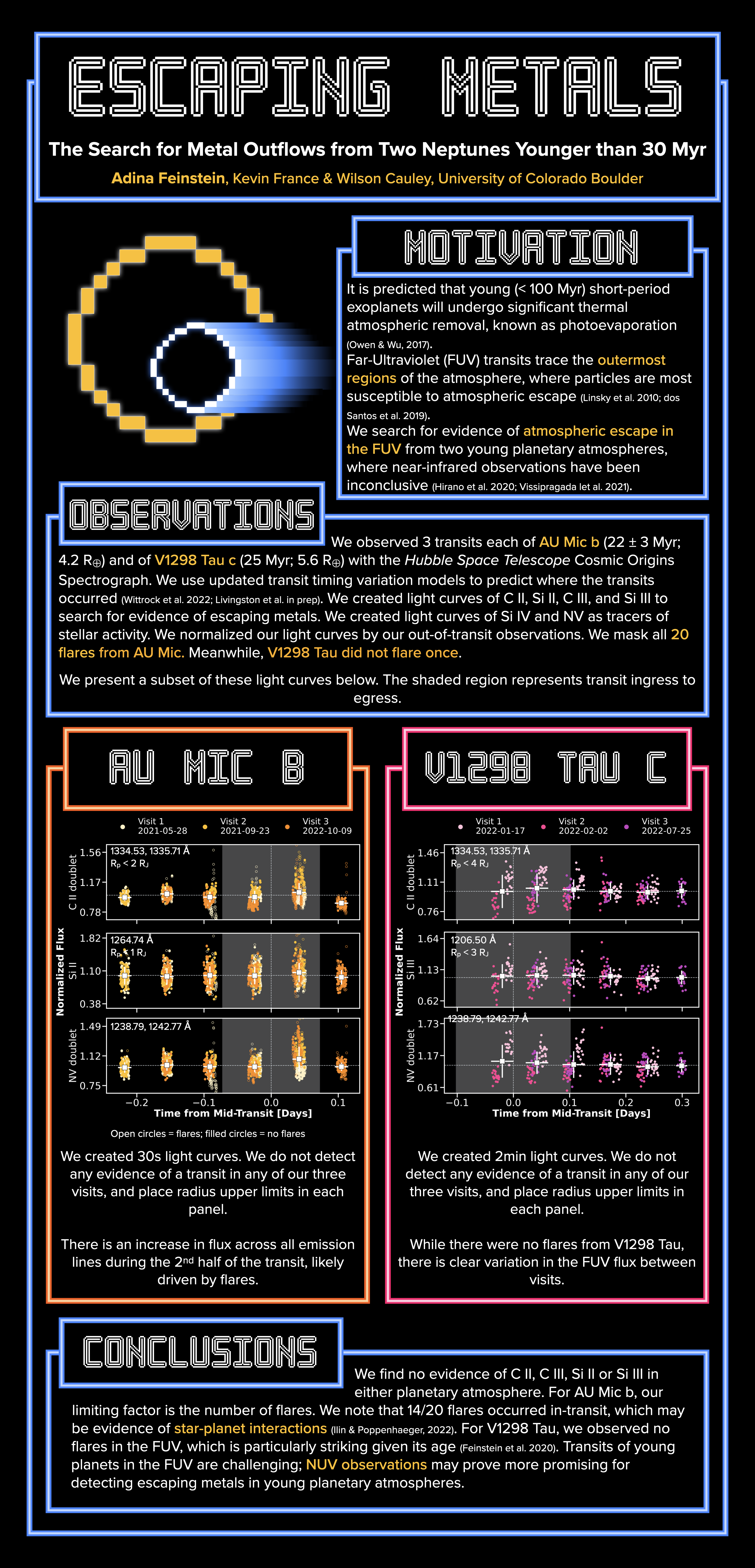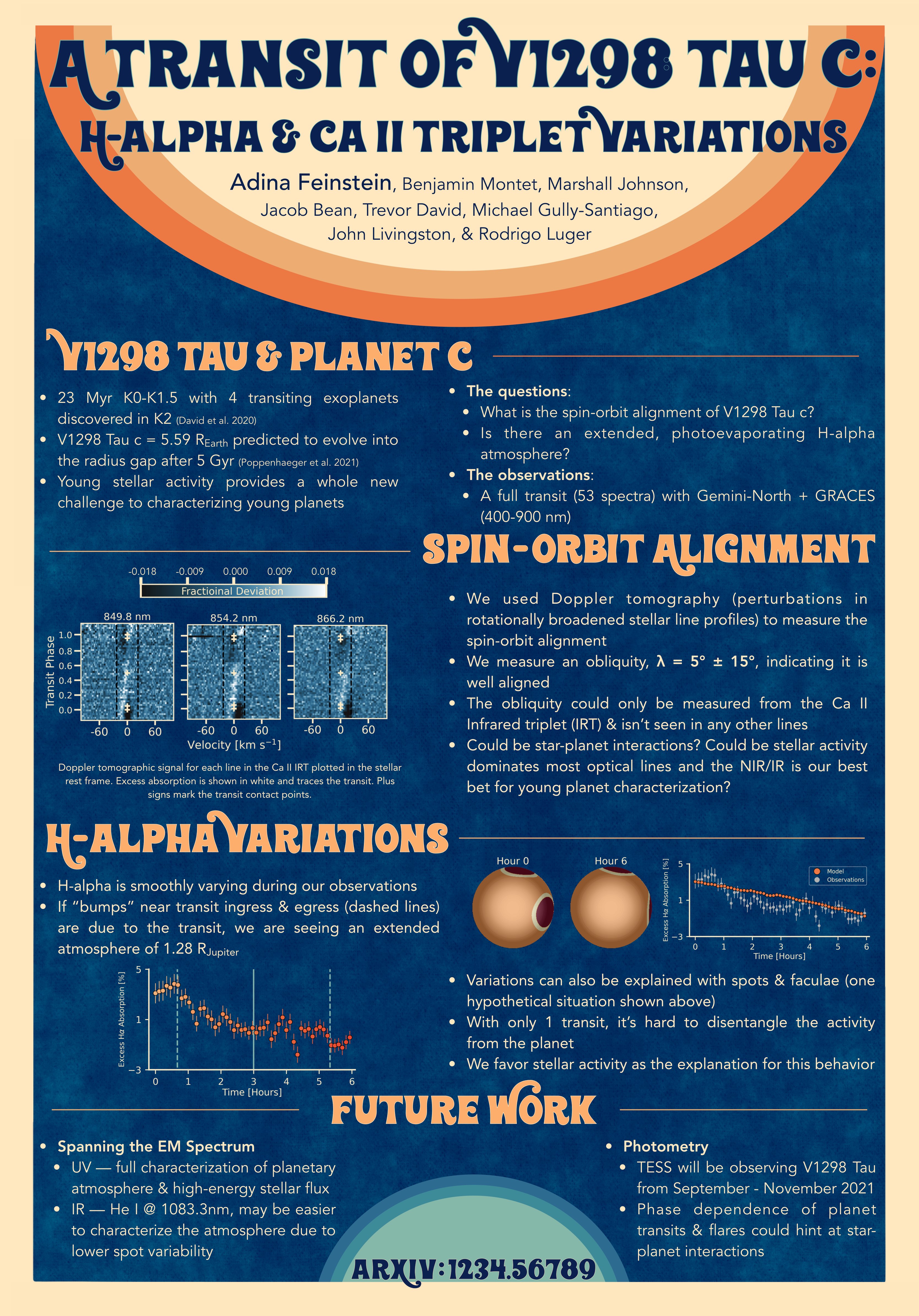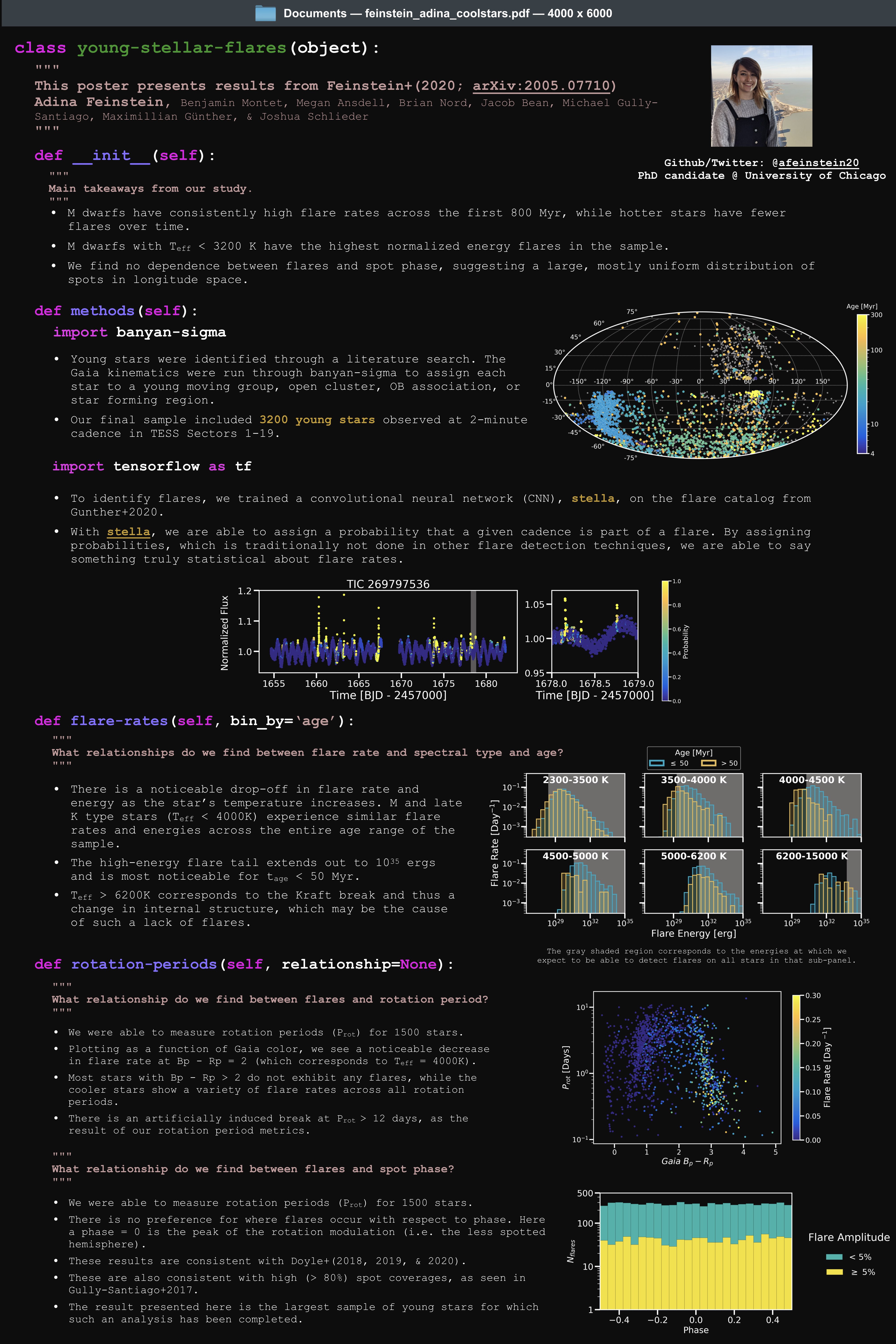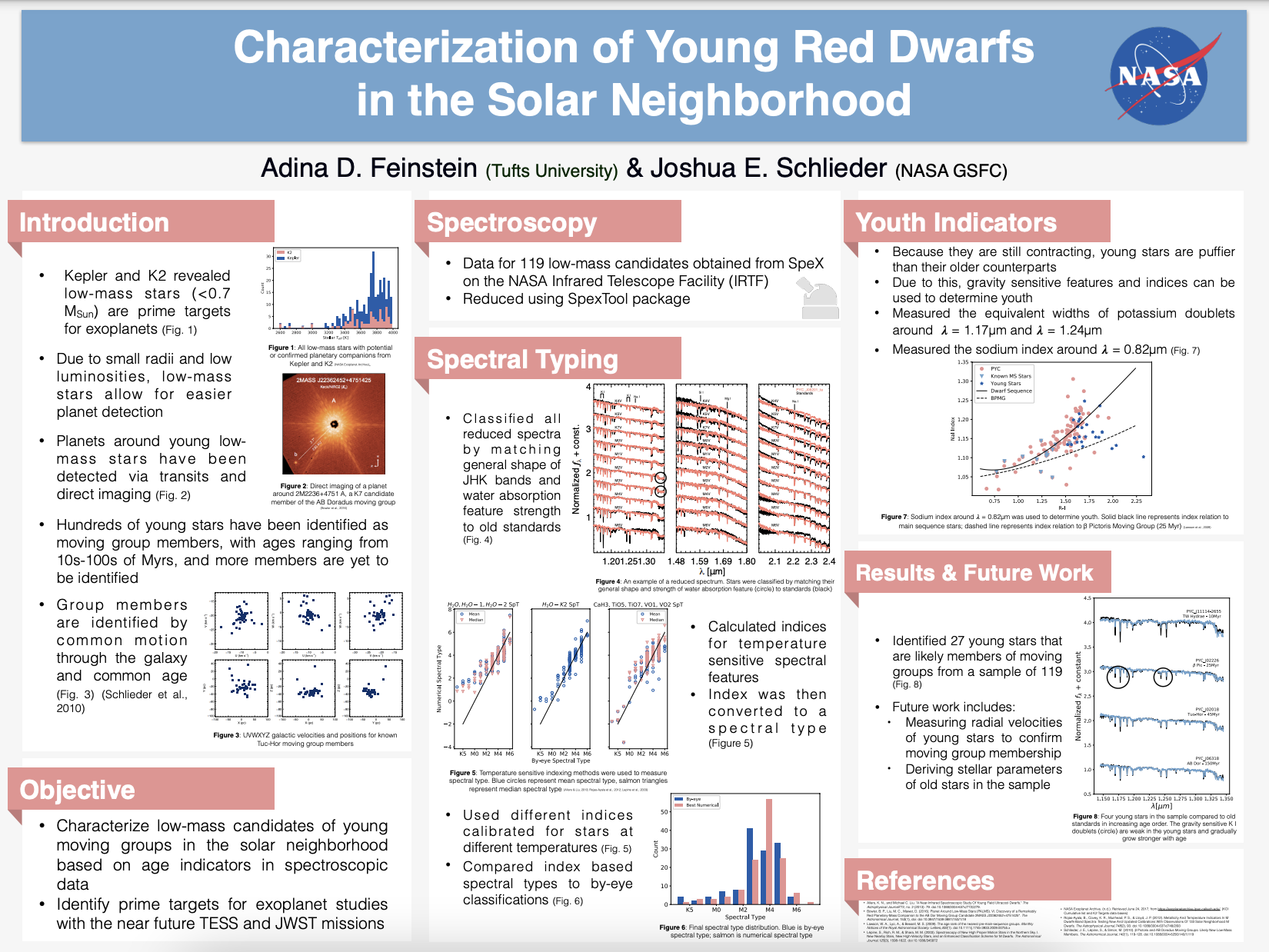Adina D. Feinstein
Assistant Professor in Physics and Astronomy at Michigan State University
Welcome
Hi! I'm Adina Feinstein. Currently, I am a NASA Sagan Postdoctoral Fellow at Michigan State University. In August 2025, I will be starting as an Assistant Professor in the Department of Physics and Astronomy at Michigan State University. My research focuses on understanding how stellar activity shapes the evolution of planets and planetary atmospheres within the first few hundred million years after formation.
Here are some quick links that may be useful:
About Me
I received by B.S. in Astrophysics and a minor in English from Tufts University in 2018. I applied to 15 Ph.D. programs as a senior undergraduate student and was not admitted to any. Instead, I joined the one-year Masters Program in Physical Sciences program at the University of Chicago. I graduated with my M.S. in 2019 before joining the Ph.D. program at the University of Chicago in the Department in Astronomy and Astrophysics. I successfully defended my Ph.D. thesis in March, 2023. From 2023 - 2024, I was a NASA Sagan Postdoctoral Fellow at the Laboratory for Atmospheric and Space Physics at the University of Colorado Boulder. Thanks to the flexibility of the NASA Sagan Fellowship, I was able to move my second year of funding to my current institution: Michigan State University.
Research Interests
I am an observational astronomer. My research focuses on understanding the early evolution of young (< 500 Myr) stellar and planetary systems, and how stellar activity will shape the evolution of exoplanet atmospheres. I use a variety of techniques to approach answering scientific questions relating to this field. My research highlights the power of conducting multi-wavelength campaigns using ground- and space-based observations from the X-ray through the infrared to shed light on how stars and exoplanets evolve.
Exoplanet Science
While planets with radii between Earth and Neptune are ubiquitous, we do not have a direct analog in our own Solar System. This type of exoplanet is often referred to as a "sub-Neptune." One way in which we try to understand what these planets are like is by studying their atmospheres via transmission spectroscopy. To do this, we observe a transit at multiple wavelengths to look for absorption from specific molecular species which may be present in the atmosphere. Atmospheric observations of mature sub-Neptunes (tage > 1 Gyr) have revealed statistically featureless transmission spectra, meaning we cannot directly detect any atmospheric species. However young sub-Neptunes (tage < 300 Myr), which have inflated radii compared to their mature counterparts, may be more favorable targets for disentangling their atmospheric compositions. I am the PI of 251 hours of JWST time (GO 5311, 5959, 8597) which will study the atmospheric composition of nine young sub-Neptunes using a combination of NIRISS/SOSS, NIRCam/F322W2/F444W, and NIRSpec/G395H. Through these programs, I aim to answer questions about (i) the compostion of sub-Neptune atmospheres; (ii) how the atmospheric properties may evolve in time; and (iii) how homoegeneity of sub-Neptune atmospheric compositions within the same and differing systems.
Stellar Astrophysics
Young stars are known to have heightened magnetic activity compared to main sequence stars. This activity can manifest in a variety of ways, such as having more starspots on the stellar surface or exhibiting higher rates of stellar flares and coronal mass ejections. We can study these events very well on the Sun, and see how the occurrence rate and strength of stellar flares changes throughout the solar cycle. However, it is harder to understand the mechanisms driving stellar flares on other stars since they cannot be resolved. My research focuses on using a combination of photometry and spectroscopy to understand flare statistics across thousands of stars and determine accurate parameters (e.g., energies, velocities, temperatures) of flares. Through this multi-prong approach, I am to provide a wholistic view of flare physics on stars other than the Sun.
(Exo)Planetary Science at Michigan State University
Michigan State Uniersity (MSU) hosts a thriving community of planetary and exoplanetary scientists conducting research linking our understanding of the solar system to exoplanetary systems. Relevant faculty are located across the departments of Physics & Astronomy and Earth and Environmental Sciences. Reflecting the exoplanetary community's priority for multi-wavelength observations to fully characterize exoplanets and their host stars, we have expertise across the entire electromagnetic spectrum including: X-ray (Jay Strader), ultraviolet, optical/near-infrared (Joey Rodriguez) and radio (Laura Chomiuk). Observational faculty expertise includes detection and characterization of new exoplanetary systems and interstellar objects (Darryl Seligman), atmospheric characterization planets, and planetary auroral emission. Additionally, we have a focused expertise on interior structure including early Solar System planetary formation and differentiation (Seth Jacobson), exoplanetary volcanism and tidal heating (Darryl Seligman), computational fluid dynamics of icy satellites and terrestrial worlds (Allen McNamara), and high-pressure laboratory experiments relevant to the past and present compositions of bodies ranging from small differentiated planetesimals to super-Earth exoplanets (Susannah Dorfman). Furthermore, faculty at MSU conduct astrobiology related research on topics including microbial life in subsurface oceans relevant to Galilean and Saturnian satellites (Matt Schrenk), extremophile ecology (Jim Moran), and microbial physiology (Annette Row).
Group Members
- Matthew Murphy (2025-) - Postdoctoral Researcher at MSU. Ph.D. earned from the University of Arizona.
- Sydney Petz (2025-) - Graduate student at MSU
- Meir Schochet (2025-) - Graduate student at MSU
- Adalyn Gibson (2024-) - Undergraduate at CU Boulder
- Ryan Groneck (2025-) - Undergraduate at MSU
- Tatianna Jefferson (2025-) - Undergraduate at MSU
Available Positions
Please don't hesitate to reach out if you have questions about any of the available positions (adina [at] msu [dot] edu).
Undergraduate Students
Unfortunately, I am unable to take any more undergraduate researchers at this time. Undergraduate students who are interested in pursuing an undergraduate thesis with me should reach out at the beginning of their junior year at the latest.
Graduate Students
Unfortunately, I am unable to take any more graduate student researchers at this time.
Graduate School Application Example
Applying to graduate school can be challenging to navigate. I seek to make this process more transparent and equitable to undergraduate students who wish to pursue a Ph.D. in astronomy/astrophysics. Our department website hosts a number of great questions to answer when applying to our program, as well as other Ph.D. programs.
Postdoctoral Researchers
Unfortunately, I do not have any postdoctoral positions available at this time. However, if you are interested in joining the MSU community, I am always happy to talk about available fellowships at the university and national levels.
Application Resources
Graduate School Application (2018) - As an additional example of ways to go abour writing the academic or research statement, here is an example of one of my own from 2018.
NSF Graduate Research Fellowship Application (2018) -
Postdoctoral Research Applications (2022) - I seek to make the postdoctoral application process more transparent and equitable to graduate students who wish to continue pursuing a career in academia. Below, I link a handful of my own applications to various fellowships, with the hopes that these examples can act as guides to those applying to postdoctoral positions.
Please do not rehost or redistribute these application materials, in whole or in part, without the express permission of the original author. You are welcome to share links to the original application bank. Reading old applications is useful for understanding how to write clearly and persuasively, but it is unacceptable to copy text, figures, or research project ideas. The content of your application must be original.
These applications do not necessarily represent the full breadth of research areas supported by the fellowship program or the only possible successful strategies.
Faculty Application (2023) -
Teaching
Fall 2025: I am in the process of developing a new graduate level exoplanet and observational astronomy course. This course is meant as an introduction to exoplanet astronomy and modern observational techniques. From the exoplanet perspective, we will focus on detection techniques and atmospheric characterization. From the observational techniques perspective, we will focus on the optical and near-infrared, with some coverage on X-ray, ultraviolet, and radio wavelengths. This course is intended to provide breadth and equip students with technical skills around how to observe and reduce observations and a skillset to evaluate and critique exoplanet-related results.
As part of my own philosophy on open science, I will be adding the slides from this class to my Speaker Deck profile and listing those links here. If you are interested in adopting these slides for your own course, you are welcome to do so with proper credit. I do not divide slides by course date, but rather by topic. Here are the most recent slides per each topic:
- 1. Planet Formation and Radio Astronomy
- 2. Spectroscopy and Radial Velocity Measurements
- 3. Photometry and Transits
- 4. Key Observational Concepts and Adaptive Optics Imaging
- 5. How to Write Observing Proposals
- 6. Exoplanet Atmospheres
- 7. UV/X-ray Astronomy and Atmospheric Escape
- 8. Other Exoplanet Detection Techniques
If you are interested in running a similar course at your university, I am happy to discuss further and share my course schedule and problem sets via email. I would like to thank Jacob Bean, Joshua Pepper, and Jay Strader for providing their course materials, from which I drew inspiration.
Software Packages
I am a strong advocate for open and reproducible science. One way in which I support this is by making all code I develop for any research project publicly available on GitHub. For code that may be of particular interest or use to the community, I bundle it up into a neat little pip installable Python package. Below are the summaries of my current pip installable packages.
pip install eleanor
eleanor is a Python package used to extract systematic-corrected light curves
from the Transiting Exoplanet Survey Satellite (TESS)
Full-Frame Images (FFIs). In its simplest form, eleanor takes a
TESS Input Catalog (TIC) ID, a Gaia source ID, or Ra, Dec coordinates of a star
and returns, as a single object, and light curve and accompanying target pixel
data. eleanor is highly flexible and customizable, allowing it to be used to
study exoplanet astronomy, stellar astrophysics, and galactic/extragalactic
astronomy. The full documentation for eleanor can be found
here.
pip install stella
The purpose of stella is to identify flares in TESS short-cadence data with
a convolutional neural network (CNN). In its simplest form, stella takes a
pre-trained CNN (details provided in Feinstein et al. (submitted)) and a
light curve (time, flux, and flux error) and returns a probability light
curve. The cadences in the probability light curve are values between 0 and
1, where 1 means the CNN finds a flare there. Users also have the ability
the train their own customized CNN architecture. The full documentation for stella can be
found here.
Paper Summaries
It's important to be able to accurately and efficiently communicate scientific results. As such, I have written summaries of my own first-author publications, similarly to astrobites. Below are summaries for several of my own first author publications.
Precovery Observations of 3I/ATLAS in TESS Suggests Distant Activity
3I/ATLAS is the third macroscopic interstellar object detected traversing the Solar System.
Since its initial discovery on UT 01 July 2025, hundreds of hours on a range of observational
facilities have been dedicated to measure the physical properties of this object. These
observations have provided astrometry to refine the orbital solution, photometry to measure
the color, a rotation period and secular light curve, and spectroscopy to characterize the
composition of the coma. Here, we report precovery photometry of 3I/ATLAS as observed with
NASA's Transiting Exoplanet Survey Satellite (TESS). 3I/ATLAS was observed nearly continuously
by TESS from UT 07 May 2025 to 02 June 2025. We use the shift-stack method to create deep
stack images to recover the object. These composite images reveal that 3I/ATLAS has an average
TESS magnitude of Tmag=19.6±0.1 and an absolute visual magnitude of HV=12.5±0.3, consistent
with magnitudes reported in July 2025, suggesting that 3I/ATLAS may have been active out at
∼6.4 au. Additionally, we extract a ∼20 day light curve and find no statistically significant
evidence of a nucleus rotation period. Nevertheless, the data presented here are some of the
earliest precovery images of 3I/ATLAS and may be used in conjunction with future observations
to constrain the properties of our third interstellar interloper.
Summary in Progress
Read the Paper
Evolution of Flare Activity in GKM Stars Younger Than 300 Myr over Five Years of TESS Observations
Stellar flares are short-duration (< hours) bursts of radiation associated with surface
magnetic reconnection events. Stellar magnetic activity generally decreases as a function
of both the age and Rossby number, R0, a measure of the relative importance of the
convective and rotational dynamos. Young stars (< 300 Myr) have typically been overlooked
in population-level flare studies due to challenges with flare-detection methods. Here,
we select a sample of stars that are members of 26 nearby moving groups, clusters, or
associations with ages < 300 Myr that have been observed by the Transiting Exoplanet Survey
Satellite at 2 minute cadence. We identified 26,355 flares originating from 3160 stars
and robustly measured the rotation periods of 1847 stars. We measure and find the flare
frequency distribution slope, α, saturates for all spectral types at α ∼ −0.5 and is
constant over 300 Myr. Additionally, we find that flare rates for stars tage = 50–250 Myr
are saturated below R0 < 0.14, which is consistent with other indicators of magnetic
activity. We find evidence of annual flare rate variability in eleven stars, potentially
correlated with long-term stellar activity cycles. Additionally, we crossmatch our entire
sample with the Galaxy Evolution Explorer and find no correlation between flare rate and
far- and near-ultraviolet flux. Finally, we find the flare rates of planet-hosting stars
are relatively lower than comparable, larger samples of stars, which may have ramifications
for the atmospheric evolution of short-period exoplanets.
The project was written and compiled using
showyourwork!.
The data and Python scripts for this project can be found on
GitHub.
Summary in Progress
Read the Paper
HST Far-ultraviolet Transit Observations of Two Neptune Progenitors Younger than 30 Myr
Photoevaporation is believed to dominate the removal of planetary
atmospheres when they are young (< 100 Myr). Signatures of atmospheric
mass-loss can be observed in the ultraviolet (UV) through the near-infrared.
We present Far-UV transit observations of AU Mic b (∼22 Myr) and V1298 Tau c (∼28 Myr)
with the Hubble Space Telescope. We search for evidence of
escaping metals in the C II, Si II, and Si III emission lines and compare
their behavior to tracers of stellar activity. We detect no evidence of
atmospheric mass loss, and place upper limits on the radii of AU Mic b and V1298 Tau c.
Summary in Progress
Read the Paper
Early Release Science of the exoplanet WASP-39b with JWST NIRISS
The Saturn-mass exoplanet WASP-39b has been the subject of extensive efforts to
determine its atmospheric properties using transmission spectroscopy. However,
these efforts have been hampered by modelling degeneracies between composition
and cloud properties that are caused by limited data quality. Here we
present the transmission spectrum of WASP-39b obtained using the Single-Object
Slitless Spectroscopy (SOSS) mode of the Near Infrared Imager and Slitless Spectrograph
(NIRISS) instrument on the JWST. This spectrum spans 0.6–2.8 μm in wavelength and
shows several water-absorption bands, the potassium resonance doublet and signatures
of clouds. The precision and broad wavelength coverage of NIRISS/SOSS allows us to
break model degeneracies between cloud properties and the atmospheric composition of
WASP-39b, favouring a heavy-element enhancement (‘metallicity’) of about 10–30 times
the solar value, a sub-solar carbon-to-oxygen (C/O) ratio and a solar-to-super-solar
potassium-to-oxygen (K/O) ratio. The observations are also best explained by
wavelength-dependent, non-grey clouds with inhomogeneous coverageof the planet’s terminator.
The code for this project can be found on
GitHub
and the data can be found on
Zenodo.
Summary in Progress
Read the Paper
AU Microscopii in the Far-UV: Observations in Quiescence, during Flares, and Implications for AU Mic b and c
High-energy X-ray and ultraviolet (UV) radiation
from young stars impacts planetary atmospheric chemistry
and mass loss. The active ∼22 Myr M dwarf AU Mic hosts two
exoplanets orbiting interior to its debris disk. Therefore, this
system provides a unique opportunity to quantify the effects of
stellar X-ray and UV irradiation on planetary atmospheres as a function
of both age and orbital separation. In this paper, we present over 5 hr
of far-UV (FUV) observations of AU Mic taken with the Cosmic Origins
Spectrograph (COS; 1070-1360 Å) on the Hubble Space Telescope (HST). We
provide an itemization of 120 emission features in the HST/COS FUV spectrum
and quantify the flux contributions from formation temperatures ranging from
104 to 107 K. We detect 13 flares in the FUV
white-light curve with energies ranging from 1029 to
1031 erg s. The majority of the energy in each of these flares
is released from the transition region between the chromosphere and the
corona. There is a 100× increase in flux at continuum wavelengths λ < 1100 Å
in each flare, which may be caused by thermal Bremsstrahlung emission. We
calculate that the baseline atmospheric mass-loss rate for AU Mic b is ∼108
g s−1, although this rate can be as high as ∼1014 g s−1 during flares with
Lflare >= 1033 erg s−1. Finally, we model the transmission
spectra for AU Mic b and c with a new panchromatic spectrum of AU Mic and motivate future
JWST observations of these planets.
The code for this project can be found on
GitHub and the
data can be found on
Zenodo.
Read the Summary
Read the Paper
Testing Self-organized Criticality across the Main Sequence Using Stellar Flares from TESS
Self-organized criticality describes a class of dynamical systems that
maintain themselves in an attractor state with no intrinsic length or
timescale. Fundamentally, this theoretical construct requires a mechanism
for instability that may trigger additional instabilities locally via
dissipative processes. This concept has been invoked to explain nonlinear
dynamical phenomena such as featureless energy spectra that have been observed
empirically for earthquakes, avalanches, and solar flares. If this interpretation
proves correct, it implies that the solar coronal magnetic field maintains
itself in a critical state via a delicate balance between the dynamo-driven
injection of magnetic energy and the release of that energy via flaring events.
All-sky high-cadence surveys like the Transiting Exoplanet Survey Satellite
(TESS) provide the necessary data to compare the energy distribution of flaring
events in stars of different spectral types to that observed in the Sun. We
identified ∼106 flaring events on ∼105 stars observed by TESS at a 2 minute cadence.
By fitting the flare frequency distribution for different mass bins, we find that
all main-sequence stars exhibit distributions of flaring events similar to that
observed in the Sun, independent of their mass or age. This may suggest that stars
universally maintain a critical state in their coronal topologies via magnetic
reconnection events. If this interpretation proves correct, we may be able to infer
properties of magnetic fields, interior structure, and dynamo mechanisms for stars
that are otherwise unresolved point sources.
Read the Summary
Read the Paper
H-Alpha and Ca II Infrared Triplet Variations During a Transit of the 23 Myr Planet V1298 Tau c
Young transiting exoplanets (< 100 Myr) provide crucial insight into atmospheric
evolution via photoevaporation. However, transmission spectroscopy measurements
to determine atmospheric composition and mass loss are challenging due to the
activity and prominent stellar disk inhomogeneities present on young stars. We
observed a full transit of V1298 Tau c, a 23 Myr, 5.59 R⊕ planet orbiting a young
K0-K1.5 solar analog with GRACES on Gemini North. We were able to measure the Doppler
tomographic signal of V1298 Tau c using the Ca II infrared triplet (IRT) and find a
projected obliquity of λ = 5° ± 15°. The tomographic signal is only seen in the
chromospherically driven core of the Ca II IRT, which may be the result of star-planet
interactions. Additionally, we find that excess absorption of the Hα line decreases
smoothly during the transit. While this could be a tentative detection of hot gas
escaping the planet, we find this variation is consistent with similar timescale
observations of other young stars that lack transiting planets over similar
timescales. We show this variation can also be explained by the presence of starspots
with surrounding facular regions. More observations both in and out of the transits
of V1298 Tau c are required to determine the nature of the Ca II IRT and Hα line variations.
The data and Python scripts affiliated with this publication can be found on
Zenodo.
Read the Summary
Read the Paper
Flare Statistics for Young Stars from a Convolutional Neural Network Analysis of TESS Data
All-sky photometric time-series missions have allowed for the monitoring of thousands of young (tage < 800 Myr)
stars in order to understand the evolution of stellar activity. Here, we developed a convolutional neural network
(CNN), stella, specifically trained to find flares in Transiting Exoplanet Survey Satellite (TESS) short-cadence
data. We applied the network to 3200 young stars in order to evaluate flare rates as a function of age and spectral
type. The CNN takes a few seconds to identify flares on a single light curve. We also measured rotation periods for
1500 of our targets and find that flares of all amplitudes are present across all spot phases, suggesting high spot
coverage across the entire surface. Additionally, flare rates and amplitudes decrease for stars tage > 50 Myr across
all temperatures Teff ≥ 4000 K, while stars from 2300 ≤ Teff < 4000 K show no evolution across 800 Myr. Stars of
Teff ≤ 4000 K also show higher flare rates and amplitudes across all ages. We investigate the effects of high
flare rates on photoevaporative atmospheric mass loss for young planets. In the presence of flares, planets lose
4%–7% more atmosphere over the first 1 Gyr. stella is an open-source Python toolkit hosted on
GitHub and
PyPI.
Read the Summary
Read the Paper
Presentations
Here are selected posters and talks I have presented over the years.
Poster Gallery
Recorded Talks
Here are a selection of talks I have presented over the years.
NASA Hubble Fellowship Program Symposium: "Flares for Stars Younger than 250 Myr:
Using TESS to understand magnetic evolution"
(October, 2023)
TESS Science Conference II: "From Images to Light Curves: An
Overview of Methods for Extracting Data from the TESS Full-Frame Images"
(August, 2021)
online.tess.science hack week: Demonstration on using eleanor to
extract light curves from the TESS Full-Frame Images
(September, 2020)
Hobbies
Sometimes, I do things outside of the office! I enjoy crocheting, cross-stitching, hiking, baking, and hanging out with my cats. Additionally, I enjoy partaking in every cozy fall activity such as apple picking, doing corn mazes, picking and carving pumpkins, and just generally enjoying fall foliage. In the winter, I enjoy spending time at home playing what would probably be considered too much Stardew Valley.
Contact Information
Email: adina [at] msu [dot] edu

